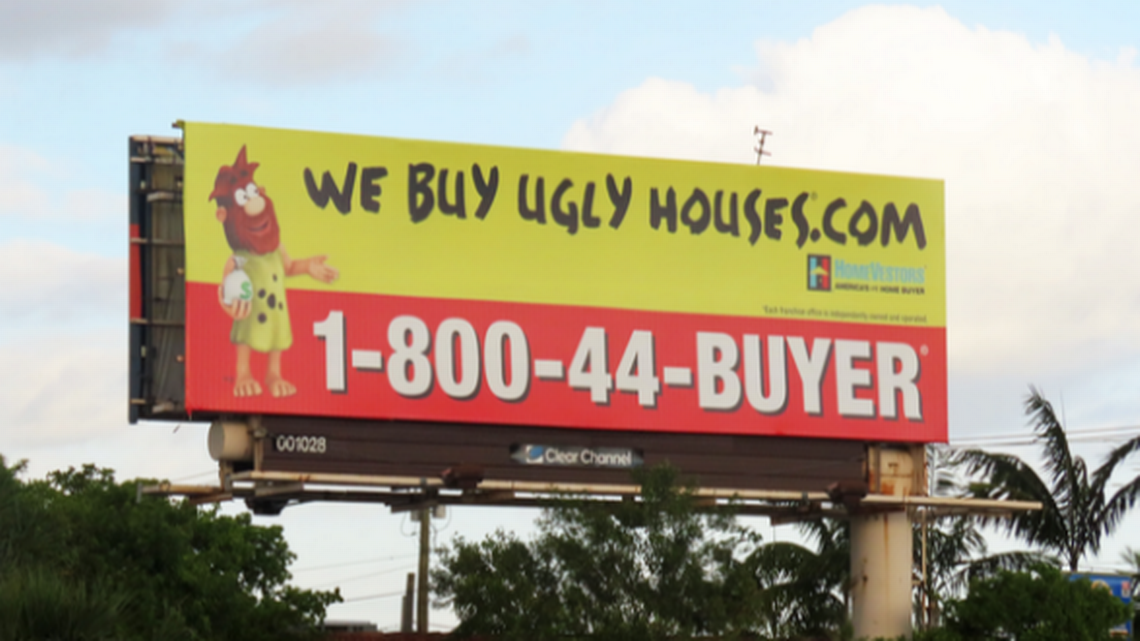Have you ever seen those “We Buy Ugly Houses” ads with the mundane caricature of a caveman offering to “purchase your burden”? If you haven’t, that’s okay—it just means your parents can probably afford to pay your college tuition. These ads are ubiquitous in lower-income communities; in fact, there’s one on a billboard off U.S. 67 as you head towards Townview from the south. If you’ve seen one of these ads before, I’m sure you were intrigued by its unconventional marketing approach. Why would anyone want to buy a home in deteriorating condition? What could its value be? Well, its value might seem minimal to a financially distressed homeowner, but to a multi-million dollar company, it could be a lucrative asset.
The Dallas-based wholesale real estate company HomeVestors owns the “We Buy Ugly Houses” ads. The company’s website claims that it buys homes that are often in need of repair for cash, rehabs them, and resells them for a profit. Presumably, their business model seems modest and benign; however, client lawsuits argue the contrary. Customers, all of whom come from destitute communities, describe being preyed upon and pressured to sell their properties well below market value. An article from the investigative journal ProPublica shares about a lawsuit from 2021, where an elderly man was coerced into selling his home for $175,000 below market value. The effect of HomeVestors’ unethical business practices is more apparent in black communities, where homeowners are more likely to be financially illiterate and desperate, according to the National Urban League. Some Black homeowners are more likely to give up their homes because they might not be able to afford the necessary maintenance to keep them in good condition. The fact that banks are less likely to approve their loan request to help them afford said maintenance is also to their disadvantage. According to CNN, Navy Federal Credit Union, America’s largest credit union, rejected more than half of its Black mortgage applicants in the 2023 fiscal year. Companies buying Black-owned properties below market value is incredibly detrimental to the potential for generational wealth—an advantage that has placed White people ahead of Black people and other historically marginalized groups socio-economically.
The practices of HomeVestors are one instance of what I refer to as the commodification of Black poverty.
Black Poverty
The commodification of Black poverty is the marketing and selling of Black individuals’ distorted economic conditions for consumer consumption. Although the commodification of poverty isn’t exclusive to Black people, it is largely marketed as “Black,” thereby reducing and undermining the complexity and image of Black America. We may not recognize it, but it is present in nearly every aspect of our daily lives—from our books and media to education to cultural expression or anything profitable in general. Poverty is mainly commodified through an element of capitalism called financialization. Economist Thomas I. Palley explains financialization as “the process whereby financial markets, financial institutions, and financial elites gain greater influence over economic policy and economic outcomes.” It is not only a key contributor to HomeVestors’ drive for gentrification but also a principal factor in our country’s income inequality and wage stagnation.
Black Aesthetic
In 2018, freelance journalist Wanna Thompson coined the term “blackfishing” to describe the practice where cultural and economic institutions exploit Black culture and urban aesthetics for profit in Black markets. Despite being coined just six years ago, the concept has been relevant in society since the 1940s, post-WWII. It began with the hipster movement, which originated from Norman Mailer’s 1957 essay The White Negro. In the essay, Mailer suggests that World War II and nuclear anxiety pushed White Americans to emulate the attitudes and behaviors of Black Americans, whom he saw as embodying a rebellious, more liberal way of life. An article from Armour Magazine, Washington University in St. Louis’s style and culture magazine, claims that “The ‘white negro’ was the original hipster, a borrower of culture, repackaged and displayed for white consumption and ownership.” White people had appropriated the modest and unconventional lifestyles of Black people that they had systematically imposed on them and then redistributed it to others for profit. Is that not bizarre and self-contradictory? Ripped jeans, which everyone wears today, originated from the hippie movement, which adopted them from Black people who were too poor to afford new jeans.
White society continues to glamourize Black marginal conditions through fashion and social media. In a paper by Wesley E. Stevens, a Black female professor at the University of South Carolina, she identifies a trending aesthetic called “hood girl culture,” which she contends is historically associated with Black women. In the paper, Stevens also assesses a post by a white Instagram model who wears “darkened foundation, large gold hoop earrings, a ‘gleaming’ Goddess nameplate necklace, and a Louis Vuitton do-rag amid the fading ‘golden hour’ light,” used to accentuate her fabricated melanated features. Furthermore, under the caption of this post is a link to the brand that sponsors the apparel and cosmetics she is wearing.
Media
Another way society has commodified Black poverty is through media. Media sensationalism, which is used to attract audiences, often reinforces Black stereotypes and the notion of inherent racial inferiority. For instance, The Jerry Springer Show frequently dramatized conflicts between lower-income Black people, perpetuating negative racial stereotypes. In Hollywood, many films utilize the “tragic black man” trope, where black men are portrayed as financially distressed, irresponsible, or dependent, reinforcing negative stereotypes about Black masculinity and economic stability.
Credit
Black people are disproportionately charged higher interest rates. A study by the University of California, Berkeley, in examining close to 7 million 30-year mortgages, found that Black and Latinx/Hispanic applicants faced interest rates 0.08% higher than White borrowers, leading to an extra $765 million in annual interest payments. These exploitative rates trap Black people in financial hardship.
References Cited:
Palomera, J. (2014). Reciprocity, commodification, and poverty in the era of Financialization. Current Anthropology, 55(S9). https://doi.org/10.1086/676420
Stevens, W. E. (2021). Blackfishing on Instagram: Influencing and the Commodification of Black Urban Aesthetics. Social Media + Society, 7(3). https://doi.org/10.1177/20563051211038236
Damon, A., Duncan, B., & Simon, M. (2023b, May 11). The ugly truth behind “we buy ugly houses.” ProPublica. https://www.propublica.org/article/ugly-truth-behind-we-buy-ugly-houses
National Urban League. (2024, August 23). Disparities in African American Financial Literacy: Serious Problems with the Concept. Nul.org. https://nul.org/news/disparities-african-american-financial-literacy-serious-problems-concept
Mailer, N. (1969). The White Negro ; Superficial Reflections On The Hipster. City Lights Books.
Tolan, C., Ash, A., & Marsh, R. (2023, December 14). The nation’s largest credit union rejected more than half its black conventional mortgage applicants | CNN business. CNN. https://www.cnn.com/2023/12/14/business/navy-federal-credit-union-black-applicants-invs/index.html
Thomas I. Palley, 2007. “Financialization: What It Is and Why It Matters,” Working Papers wp153, Political Economy Research Institute, University of Massachusetts at Amherst. https://papers.ssrn.com/sol3/papers.cfm?abstract_id=1077923













